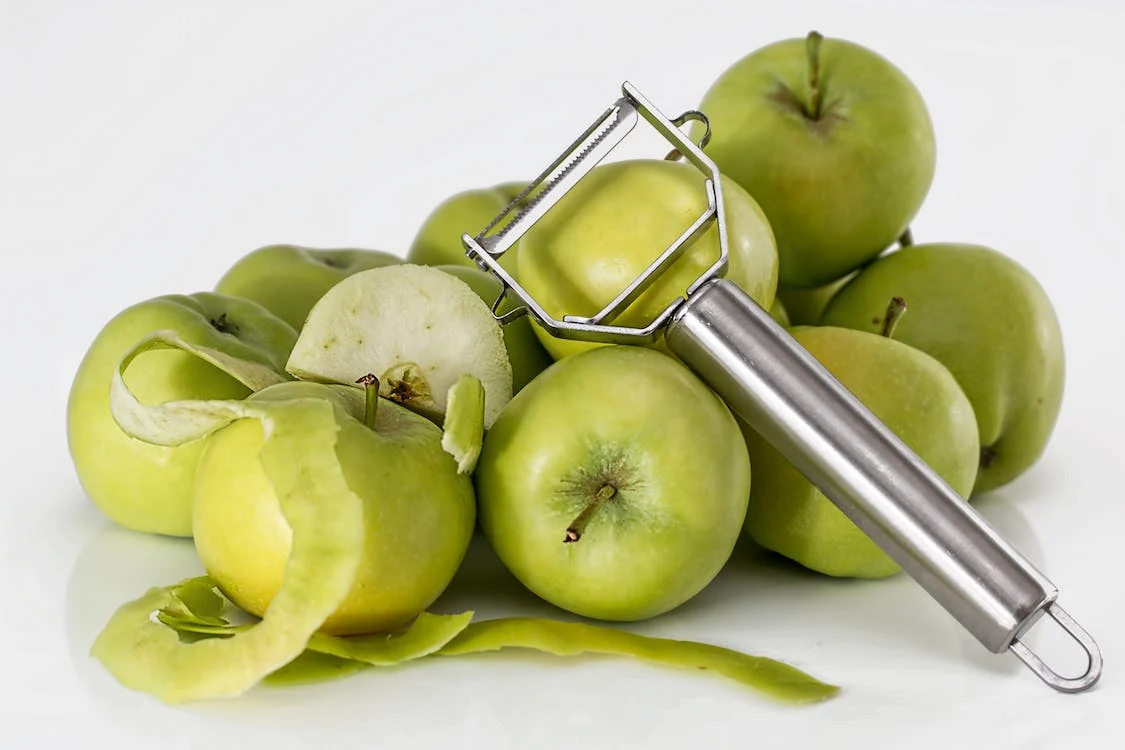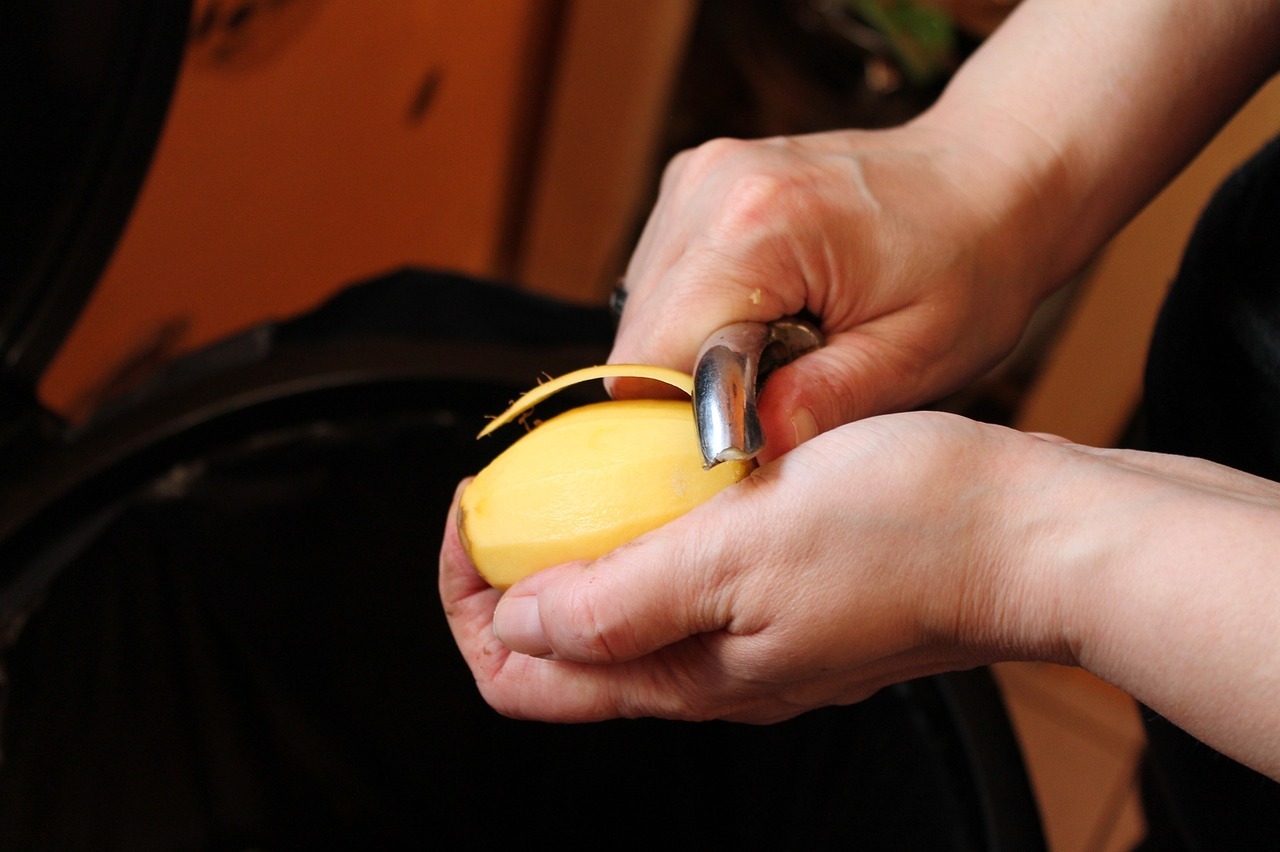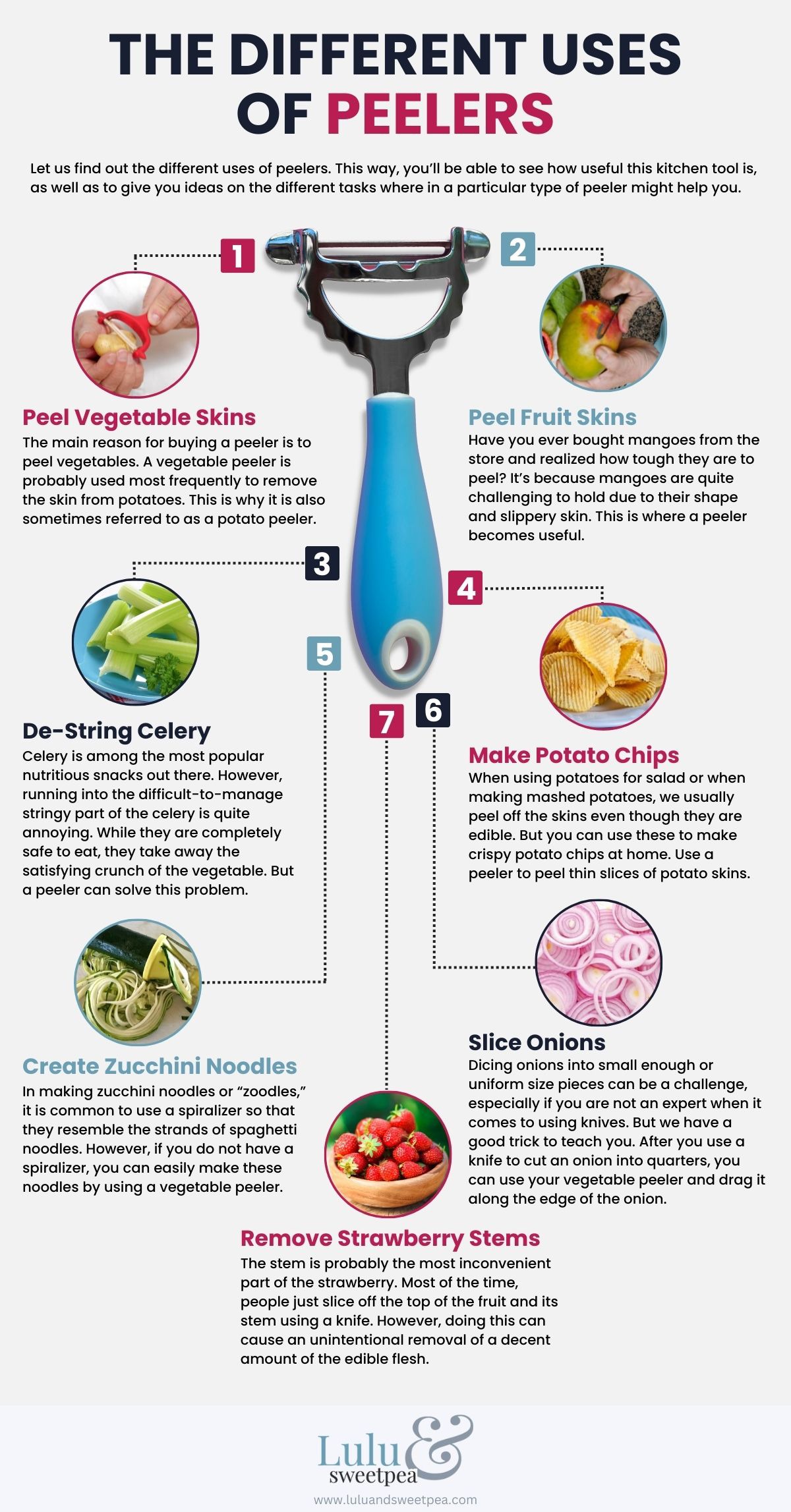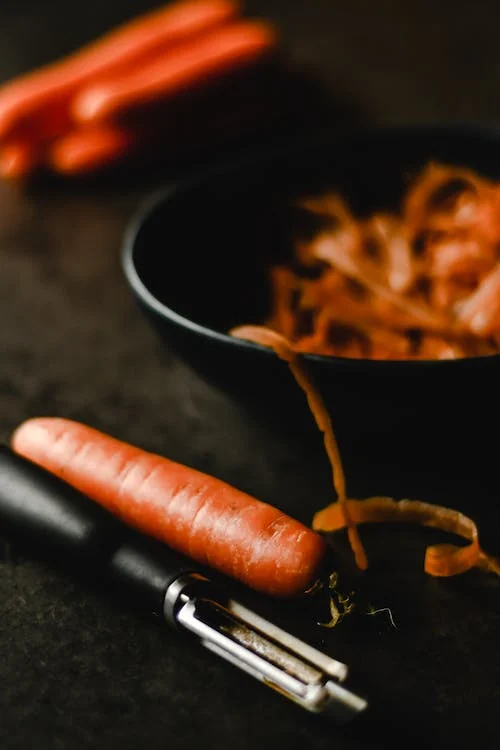Peeling may seem to be a simple process, but those of us who cook on a daily basis know that it can be tiresome and even difficult if done with the wrong tool. Even though you don’t need a lot of experience or talent to peel fruits and vegetables, you will want to invest in a long-lasting, sharp tool that can handle a wide range of produce. Thankfully, peelers are invented. A peeler is a hand-held device used to peel fruits and vegetables. It is also known as a vegetable peeler or paring knife. This helpful kitchen tool makes peeling fruits and vegetables easier and safer for the hands and fingers.
One of the most unassuming kitchen tools is the vegetable peeler. At first look, it seems to serve just one purpose. Probably once a month, when you need to peel some carrots or potatoes, you take it out of the drawer, use it, and then quickly forget about it. The vegetable peeler, on the other hand, can be used for slicing cheese. Its secret power is that it makes perfectly sliced parmesan and cheddar cheese.
Choosing the best peeler for your kitchen is a crucial choice for every cook. There are a variety of peelers available on the market, each of which is designed for specific varieties of produce and has unique features. When preparing meals, the appropriate peeler may help you save time and work while ensuring the safe and efficient peeling of fruits and vegetables. We will walk you through the process of choosing the best kitchen peelers for your home kitchen in this article.
The Different Types of Peelers You Need to Have
There is a wide variety of peelers on the market, each catering to a certain set of customers with specific requirements. We’ve compiled a list of peelers and their respective functions. Check them all out and choose the one that works best for you.
Standard Peelers
Standard peelers feature a blade with a fixed handle and a pivoting tip. The interior curve of the blade is sharpened so that when the fruit or vegetable being peeled is kept in place by the fingers wrapped around the handle, it may be readily removed without needing much effort to push against it. Larger fruits and vegetables like apples, potatoes, onions, and cabbages work best with this kind of peeler.
The following are the several varieties of standard peelers:
1. Straight Peelers (Lancashire Peeler)
Almost every home has a straight blade peeler, the most fundamental tool for preparing food. They can handle the majority of peeling chores.The peeler’s narrow, sharp blades make quick work of the skins of carrots, cucumbers, bottle gourds, and other vegetables.
To remove the skin, press the blade outward along the fruit or vegetable.
2. Swivel Peelers (Jonas Peelers)
The most common peelers on the market are swivel peelers, which have a straight handle and a vertical blade that rotates as you push down on fruit and skims over its skin to remove it.
3. Julienne Peeler
Julienne peeler, as the name implies, is incredibly handy if you want to cut vegetables into juliennes. The peeler’s uniquely designed blades make it simpler to cut the juliennes in a single pass, which is difficult to do if you depend on conventional methods. Therefore, if you want to cut juliennes as quickly as possible, you should search for a reliable and effective Julienne peeler from a reputable brand.
4. Speed Peeler
Those searching for a speedier and more dependable peeler for the home will find the speed peeler to be an ideal purchase. The speed peelers let you peel quickly and easily. The blades of a speed peeler are positioned in a manner that makes grating quick and easy, which sets it apart from other types of peelers. So, if you want a peeler that can also cut your fruits and vegetables, the speed peeler is a great choice.
Y-Shaped Peelers (Swiss or Speed Peeler)
If you’re shopping for a peeler and want one that’s simple to use yet powerful enough to peel most of the fruits and veggies you purchase, the Y peeler is a great option. The peeler’s unusual Y-shaped frame makes it one of the simplest methods to peel a fruit or vegetable. A long grip and efficient blade allow excellent control over movement and a flawless peel. So, if you’re looking for a versatile peeler that can be used on any soft-shelled fruits, the Y-peeler is an excellent choice.
Y-shaped peelers may be either serrated or non-serrated. Serrated peelers feature a serrated blade, similar to what you’d see on a bread knife. The serrated edges are great for slicing through fruits and vegetables without crushing them. This makes them ideal for delicate fruits and vegetables, including tomatoes, eggplants, apricots, kiwis, and more.
Electric Peelers
When you have a lot of peeling to do, it can be hard to sit down with a hand-held peeler. An electric peeler simplifies the task. You can peel your vegetables quickly and easily by just placing them on the peeler. It’s perfect for huge jobs, and it’s also helpful for those who have trouble or discomfort while using a hand-held peeler. Electric peelers need to be put into a power port, but some come with battery packs so they can be used on the go. Electric peelers come in two varieties: hand-held and countertop.
Handheld peelers are small, inexpensive, and don’t weigh much. They are more flexible than countertop ones and can peel a wider range of fruits and vegetables, but they aren’t the finest instrument for peeling many pounds of fruits or vegetables. Most of the time, a hand-held peeler can handle carrots, potatoes, cucumbers, oranges, squash, beets, and more.
If you need to peel a lot of vegetables or fruits quickly, a countertop peeler is your best bet. With lengths between 10 and 15 inches, they require more space in kitchen cabinets and on countertops. They are also more difficult to clean due to their multiple movable components. The blades of a countertop peeler often need to be removed and hand-washed, while the body just has to be cleaned with a damp cloth.
Specialty Peelers
Peelers made specifically for a certain kind of produce are known as specialty peelers. Citrus, pineapple, and tomato peelers are some examples of specialty peelers.
A citrus peeler is a handy kitchen tool for quickly and simply removing the skin off oranges, grapefruits, mandarins, and other citrus fruits.
Pineapple peelers are useful kitchen tools for swiftly and simply removing the skin and core of a pineapple. Although they come in a variety of sizes and designs, the most of them contain a blade that can cut through the skin of a pineapple and a corer that can extract the fruit’s core.
Things to Consider When Choosing a Peeler
You want to buy a new peeler, but with so many options, how do you know which one is best for you? Don’t worry, we’re here to assist you. We’ll go through things to look for while selecting one.
So, whether you’re a beginner just starting out or an expert cook looking for a new peeler, here are some things to think about while selecting a peeler.
- Type of Produce. Because there are peelers that are better suited for soft-skinned produce and others that are ideal for tougher and thicker skins, it is essential to take into consideration the types of fruits and vegetables that you often peel before purchasing a peeler.
- Blade Material. The blade of the peeler is its most vital part. Certain veggies may be difficult to peel, so it’s important to have a sturdy, sharp blade that also retains its sharpness.
Carbon steel, ceramic, and stainless steel are the most popular types of blade materials. By far, the most common blades are made of stainless steel, which is the only material that can be sharpened like a knife. Ceramic blades are as sharp as stainless-steel blades, but they are not as strong or durable and can break or get dull more easily. Lastly, if you don’t take care of your carbon steel blades, they’ll rust. This means you’ll have to wipe down the blade after every use so it doesn’t get wet.
- Blade Design. The blade’s design is just as important as the material it’s made of. Some blades have serrated edges, while others are very sharp. Consider which is more appropriate for the types of foods you’ll be peeling.
If you prefer both serrated and straight blades, you may get peelers with many blade choices in one. Additionally, a swivel blade gives you considerably more flexibility to peel in both directions, while a stiffer, fixed blade requires that you hold it at the correct angle in order for it to catch the peel. Consider how the blade peels efficiently and thoroughly. The space between the two blades on each peeler is different. When the second “guiding” blade has a higher edge, less of it will touch the food, making it easier for the first blade to peel. Some blades are also broader than others, which may be useful if you deal with bigger produce.
- Comfort and Grip. It would be ideal if you could put the peeler to the test physically. Make sure that it has a good grip, that it is easy to grasp, and that it gives you a sense of safety when you have it in your hand. Peelers need to come with handles that are both comfortable to hold and built of high-quality materials.
- Durability. Now that you know the different kinds of peelers, you’ll agree that it doesn’t make much sense to have to buy new ones all the time. Peelers clearly do not last forever, but it is beneficial to pick one that will last for some time. Therefore, finding a model that is both durable and affordable is an important consideration.
- Ease of Use. Once you’ve settled on a design and material, the next thing to think about when shopping for a peeler is how easy it is to use. If you want to reduce the strain on your hands and wrists, look for models with cushioned, soft grip handles or invest in an electric one to do the work for you.
- Price. Kitchen peelers are available in a variety of price ranges, from low-cost alternatives to high-end versions. While it may be tempting to choose the least expensive option, making a long-term investment in a high-quality peeler will save you time and work. Find a peeler that fits within your price range while yet providing the qualities and functionality you want.
If you want to learn more about the different uses of peelers, check out this graphic for more guidance:
Benefits of Having Multiple Types of Peelers in the Kitchen
Having a variety of peelers in your kitchen may help make prepping fruits and vegetables simpler and more effective.
Different Produce Requires Different Types of Peelers
There is a peeler designed for every task. Different peelers are needed for different kinds of vegetables. For instance, a straight peeler’s sharp, straight blade is perfect for peeling produce with smooth skin, including apples, carrots, and potatoes. Serrated peelers, on the other hand, are ideal for soft-skinned vegetables such as tomatoes and peaches. Y-shaped peelers are also useful for peeling veggies like cucumbers and zucchini.
Having Multiple Types of Peelers Allows You to Work More Efficiently in The Kitchen
In the kitchen, versatility is key, so having up on several kinds of peelers is a good idea. Peelers come in a variety of shapes and sizes and may be used for a variety of tasks such as peeling vegetables, fruits, and ginger skin. Some of the most popular peelers are straight-blade peelers for vegetables, julienne peelers for cutting pieces of vegetables, Y-shaped peelers for removing ginger skin, and serrated peelers for oranges and lemons. Having a variety of peelers may also save you time while cooking meals since you won’t have to switch between tools.
Using The Right Peeler Can Result in Less Waste
Less waste may be produced by using the right peeler. You may peel more effectively and waste less food by using a right peeler. For example, a Y-shaped peeler works well for peeling potatoes and carrots since it takes less of the produce than other peelers.
Conclusion
A peeler is an essential must-have in every kitchen. It may make preparing fruits and vegetables much simpler.
There’s a specific peeler for each job and variety of fruit or vegetable. By knowing them, it will be easy for you to buy the best one for your wants.
Having numerous peelers in the kitchen may allow you to work more effectively, thus investing in high-quality peelers is essential if you want to enhance your food preparation and cooking abilities.





